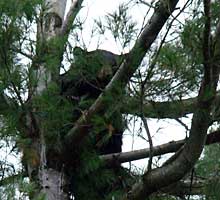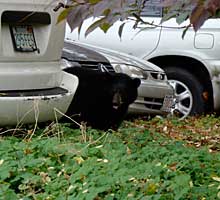Was
That a Bear on Campus?
From a distance, they can look cute and cuddly. They climb
the trees around campus, amble through parking lots and attract
the curious ogles of staff, faculty and students.
A recent spate of black bear sightings on and around campus
has inspired impromptu photos and intrigued conversations
both in person and online.
Bear on Campus:

Last week, a black bear
drew a crowd of spectators in the parking lot behind
the Alumnae House... |

...relaxing in a tree... |

...and ambling between
the cars (photos courtesy of Barbara Pliska). |
“Saw a bear 15 minutes ago by Lamont house, kinda
small, black,” remarked one person in a popular electronic
social forum on Nov. 6 at 8:43 a.m. “Yeah, there was
a bear behind Albright House!” came a response at 1:43
p.m. And finally: “Aww, black bears are cute.”
Cute, yes, from a distance. And these black bears hardly
pose a threat to people, assures Ralph Taylor, manager of
the Connecticut Valley District of Massachusetts Wildlife
in Belchertown, an office within the state Department of
Fish and Game.
“Black bears are pretty much benign,” said Taylor, “and
very unlikely to attack humans. However, at the same time,
they are unpredictable, so use caution around and near them.
Keep your distance and try not to get trapped.”
Taylor estimates there are more than two dozen bears living
in Northampton, an unusually high number that has likely
grown in recent years because of human behavior. As the popularity
of installing bird feeders and distributing birdseed has
increased during the past two decades, the population of
bears has exploded, he said. Black bears are especially fond
of the black sunflower seeds common in birdfeeders, said
Taylor, because they are coated with a tasty and nutritious
animal product.
“We have so many bears in Northampton,” he said. “They’re
attracted by bird feeders, and they have become a trained
population. They’ve learned when people leave for work
and when they return, so that between the hours of 10 a.m.
and 3 p.m. you’re more likely to see them wandering
around.”
Barbara Pliska, manager of the Computer Store in Stoddard
Hall, joined about two dozen other onlookers one morning
last week to observe a bear in a tree in the garden behind
the Alumnae House.
“It was so fascinating watching the bear,” she
said. “This was the closest I’ve ever been to
a bear in the wild. It was amazing to watch this beautiful
animal.”
“Public safety has been
notified about a few bear sightings on campus,” said
Paul Ominsky, director of public safety. “So far, they
have evaded officers. If we do spot one, we attempt to keep
people out of the area until the bear ambles elsewhere.”
Though the bear count has been up across the state in recent
years, according to Taylor, officials have no reason to intervene,
by trapping or destroying the animals, for example. The bears
have not proven to be a threat to humans or animals, he emphasized.
Massachusetts Wildlife
has affixed radio-transmitting collars on six bears in
Northampton to keep track of their habitat and activities,
he said. And the state’s hunting season
was extended this fall due to the number of bear sightings,
but that does not have an impact on the population of bears
in town.
Finally, Taylor said, the onset
of winter may not curtail the bear population because the
animals have no need to den and sleep through the season
as long as food is plentiful, as the bears seem to have discovered
in Northampton.
So the bear sightings
on campus will likely continue—good
news, perhaps, for those who find them cute. |























